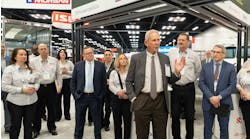LOUISVILLE. With Class 8 sales in the U.S. “the driving force,” medium- and heavy-duty truck sales in North America this year will grow 10% over a very solid 2014 and could quite possibly be even higher, according to Martin Daum, president and CEO of Daimler Trucks North America. Officially, Daimler sees Class 6-8 sales in North America trending around 411,000 units for 2015, but “I believe they could be even higher than 10% by the end of the year, and could end up somewhere in the range of 411,000 to 453,000,” Daum said at a press conference during the Mid-America Trucking Show.
Medium-duty sales in the U.S. will essentially remain flat between 100,000 and 103,00 trucks, he said, but Class 8 could be up 19% over 2014 and might surpass 229,00 trucks. “If you ask me how the market is now, in German I’d say not bad, which in English means awesome,” Daum said.
Turning to DTNA specifically, Daum said the company was adding enough capacity to build an additional 27,000 trucks this year. “I have no fear those production slots will go empty, and in fact they may not be enough.”
On the Detroit powertrain component side of the business, Daum said customer acceptance of the DT12 automated mechanical transmission is particularly strong. Current production levels are almost five times those initially anticipated back in 2012, and even then the year’s build is already completely sold out, he said.
On the regulatory front, Daum reported that DTNA has already submitted all the required data to the Environmental Protection Agency to get certification for the 2017 greenhouse gas (GHG) emissions and fuel economy standards. “We’re not certified yet, but we intend to be the first to be certified,” he said.
As for the Phase 2 GHG standards now under development, Daum said EPA and the industry as a whole were working well in a collaborative process. DTNA’s position is that any new truck fuel economy requirements be based on the total vehicle rather than just the engine, and that any proscribed test cycles mirror real-world conditions rather than require bench tests. He also said they need to acknowledge total cost of ownership by relying on feasible technologies that can meet customer expectations of 18 to 24 month paybacks.


